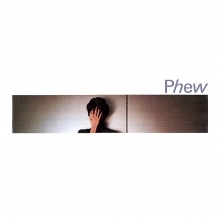
Her trajectory is direct and contained moves forward like an arrow: she doesn't look back. Despite this, she remains somewhat outside of the canon of experimental electronic music, although one gets the feeling being canonised is last on her list of priorities. Her catalogue spans Osaka punk, collaborations with the kings of kosmische, sprawling experimental Japanese underground supergroups and, in the last decade, a flawless run of solo voice and electronics albums. Plain-talking in interviews as well as in her distinctive singing style, her almost-spoken not-quite-sung delivery is a red thread that connects all her work and frequently acts as the anchor in the groups she's played with.

Listen to the shows live when they air or click on any show below to listen at any time you like in the archives.If punk is a state of mind, Phew – Hiromi Moritani – is as punk as they come. Tune in this Wednesday, May 21, from 7-10 PM EDT, when Bodega Pop Live on WFMU's Give the Drummer Radio spins classic, deep, and rare eighties cuts by some four dozen Japanese she-punks.īodega Pop Live airs Wednesdays from 7:00-10:00 PM Eastern Time on WFMU's Give the Drummer Radio Some say it was Shonen Knife’s example that led to a surge in female-forward acts-Naoko and Atsuko showed that women could make their own music, their own way, and become popular overseas doing it. The Runaways were big enough in Japan to warrant a 1977 visit they must have inspired some women to pick up a guitar, drumsticks, or a microphone. That’s just a handful of artists, but a good number compared to the previous decade in Japan, where women were mostly absent among the country’s psychedelic-era history makers. Memi, the Comes, Go-Bangs, G-Schmitt, Kadorie, Katra Turana, Nurse, Rap. Throughout the 1980s, Japanese punk proliferated, mutating into its inevitable offshoots (hardcore, new and no wave, minimal synth, post-punk, avant-pop), and women spearheaded several of the decade’s era-defining forces: After Dinner, C. And, yes, their poetically kooky English-language lyrics were charming. Because, first, that’s who got picked up here. No doubt there were a handful of savvy music obsessives flying over the Pacific to hunt down the Vanity Records catalog with Friction and the Stalin blasting through their Walkman headphones. I left Tower just before the tribute Every Band Has A Shonen Knife Who Loves Them dropped I’m guessing it was even more popular among the staff.įrom our vantage point back then, Shonen Knife was Japanese punk.

release of Burning Farm and Pretty Little Baka Guy were on regular rotation at the San Francisco branch of Tower Records the whole year and change I worked there in the late eighties. Germany fell in love with Phew-her self-titled debut was engineered by Conny Plank Holger Czukay and Jaki Liebezeit from Can provided the bounce and beat-and she later collaborated with DAF’s Chrislo Haas, Einstürzende Neubauten’s Alexander Hacke, and Rabotti’s Thomas Stern.Īmerica fell for Shonen Knife: the U.S.

The short list would have to include Aunt Sally’s pioneering Aunt Sally (1979) and lead singer Phew’s bold leap forward Phew (1981), as well as Plastics’ B52’s-inspired Welcome Plastics (1979), Noise’s brilliantly stripped-down Emperor (1980), Tolerance’s darkly futuristic, proto-EDM Divin and Mizutama Shobodan’s sublime Maiden’s Prayer Da Da Da! (both 1981), and probably the greatest Japanese post-punk record of them all, Saboten’s Floor (1982).
PHEW 1981 SERIES
By the time Shonen Knife were passing around the 50 copies of their self-released cassette demo, Everybody Happy (1982), Japanese all-girl and female-fronted acts had already left a series of deep and lasting marks on the archipelago’s punk scene.


 0 kommentar(er)
0 kommentar(er)
